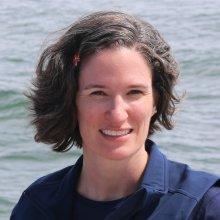
Valerie Grussing
Tell us about your work / research. What kinds of things do you do?
I work broadly in cultural and historic preservation, considering cultural heritage inclusively not just as tangible objects and sites, but also as intangible values and knowledge. I work on federal policy issues, helping ensure that cultural heritage is considered in planning and decision-making, incorporating a wide variety of voices and perspectives. I work with stakeholders and partners on managing special places in the coastal and ocean environment, including indigenous communities who have maintained unique relationships with the land and water since time immemorial. A cultural landscape approach to policy and management recognizes that the human family is an integral part of, and has special responsibilities to, the environment.
What sparked your initial interest in your career?
I started out in archaeology because I am fascinated by where we come from. I studied the Roman period in college, then the Paleolithic period, and finally underwater archaeology in graduate school. I wanted to be a paleoanthropologist, working with ancient bones (instead of living people and the accompanying complexities) and making groundbreaking discoveries about ancient forms of humans in the Old World. Then I realized that tenure track life was not for me. Underwater archaeology brought me back to my love of the water, and introduced me to the great need and possibilities of working in federal policy, which I admit that I enjoy!
Who influenced you or encouraged you the most?
My parents always encouraged and enabled me to pursue my interests and dreams. My native friends and colleagues have generously shared their time and passion, and their friendship and trust is a strong motivator to do this work.
What element of your work / study do you think is the most fascinating?
I have excavated artifacts and remains in Jordan, France, and the U.S. The thrill of being the first person to see and touch something from thousands (or tens of thousands) of years ago is truly unparalleled. Although I have not done sexy field work in my current position, I get to influence the way our government approaches the management of our shared heritage and advocate for people who have been underserved and underrepresented. I am excited about the possibility of rewriting history collaboratively with these populations – both telling their untold stories, and also helping change the course of history, creating a future in which they re-establish the foundation of their culture, knowledge, traditions, and language. This process heals individuals, communities, and indeed the planet we all share.
What other jobs led you to your current career?
I have taken a circuitous path from aspiring paleoanthropologist to my current work. As a student, I did Roman archaeology, Paleolithic archaeology and biological anthropology, and nautical archaeology. I have excavated sites in Jordan, France, and the US, including the site of Queen Anne’s Revenge, the wreck of the pirate Blackbeard’s flagship. I have enjoyed creative outlets of artifact casting and illustration. Throughout it all, I have wanted to make a difference in Native American communities. In my current position, I have been able to pursue policy and management issues related to indigenous concerns and strongly advocate for native interests in federal planning and decision-making.
What are your degrees and certifications?
Bachelor of Arts in History, with minors in Anthropology, English, and French – North Carolina State University 2000; Master of Arts in Anthropology – University of Iowa 2002; Ph.D. in Coastal Resources Management – East Carolina University 2009; Basic SCUBA and Scientific Diving; CPR and First Aid.
What are your hobbies?
I love to make jewelry inspired by nature and archaeology, as well as words that move people. I love to draw and color and to play and swim with our joyful, fearless toddler.
What advice would you give to someone who wants to have a career like yours?
Archaeology isn’t really about digging up artifacts and putting them in a museum (like Indiana Jones, although he was a terrible archaeologist). Archaeology’s most exciting possibilities involve bringing our past alive, actively involving communities in discovering and telling their own stories, and finding out how past societies succeeded and failed. Applying lessons learned from how our ancestors adapted to (or in some cases, did not) changing conditions can help us not to repeat past mistakes. That is, if we pay attention. Archaeology has a renewed sense of urgency in 2017; responsible practitioners find a bigger purpose in our work using our knowledge and voices to help society move forward together. I would say to "never doubt that a small group of thoughtful, committed citizens can change the world; indeed, it's the only thing that ever has." - Margaret Mead (Anthropologist)
How did you get involved with the Nautilus Exploration Program? How did you get on the ship?
I accepted an invitation from some of my tribal partners to represent their perspectives and voices while the ship explores ancient shorelines and landscapes now submerged in the ocean. It is a tremendous honor and privilege to be entrusted with this responsibility.
Expeditions
Valerie participated in the following Ocean Exploration Trust expeditions:
